CIRCLE TIME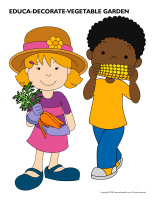
Arrange pictures of different vegetables on the floor, forming a circle where children can gather for circle time.
Before they arrive, use pictures of vegetables to draw a path from your daycare entrance to your circle time area.
Animating your morning routine, presenting vegetables
Cut several pictures or illustrations representing different vegetables and present them to your group. You may add pictures of items used for gardening such as gloves, a spade, a watering can… Use the items to encourage children to tell you everything they know about the theme.
AREA SETUP
A treasure hunt to discover the theme
(Open educa-decorate-Vegetable garden) Print and laminate. Set the illustrations on items throughout your daycare. Encourage children to collect them. Name the items as they hand them to you. Invite children to guess the theme.
Educa-decorate-Vegetable garden
(Open educa-decorate-Vegetable garden) Print, laminate, and cut out the various items. Use them to decorate your daycare and set the mood for the theme.
Hanging veggies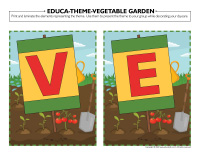
Hang plastic vegetables from the ceiling within your daycare. Press pictures of vegetables on your daycare walls.
Thematic poster-Vegetable garden
(Open thematic poster-Vegetable garden) Print and display within your daycare to introduce the theme.
Educa-theme-Vegetable garden
(Open educa-theme-Vegetable garden) Print and laminate the elements representing the theme. Use them to present the theme to your group while decorating your daycare.
Stickers-Vegetable garden
(Open stickers-Vegetable garden) Print the illustrations on adhesive paper and use them to create original stickers.
PICTURE GAME
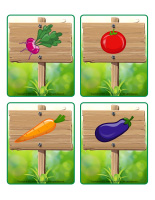
(Open picture game-Vegetable garden) Use the pictures to decorate your daycare or to spark a conversation with your group. Print, laminate, and store the pictures in a Ziploc bag or in your thematic bin.
Memory game-Vegetable garden
(Open picture game-Vegetable garden) Print the illustrations twice and use them for a memory game.
ACTIVITY SHEETS
(Open activity sheets-Vegetable garden) Print and follow instructions.
WRITING ACTIVITIES
(Open writing activities-G like garden) Print for each child or laminate for use with a dry-erase marker.
VARIOUS WORKSHOPS-Vegetables
Have fun with these wonderful workshop ideas created by Caroline Allard.
Construction/Building blocks:
- Use plastic or paper drinking glasses for all kinds of constructions.
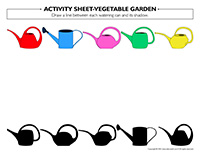
- Drinking straws can be used to build fences, pillars, or decorations.
- Aluminium plates in different sizes can add a touch of “shine” to children’s constructions.
- Use clean individual yogurt or applesauce containers instead of traditional building blocks. Ask parents to help you collect them!
Arts & crafts:
- Use dry pasta, rice, or cereal for all kinds of collages.
- Children can cut vegetables out of grocery store flyers and use them to create an enormous salad or feast.
- Pour poster paint in muffin cups and encourage children to paint with pastry brushes.
- Press cookie cutters in paint and use them to make prints.
- Use various vegetables and other food items to make prints (cut peppers, potatoes, carrots, etc.).
- Make your own maracas using plastic containers with a lid. Fill them with seeds, pasta, or rice.
- Recycle empty food packages and containers and use them to build a city for toy cars.
- All crafts that involve food items.
Drawing:
- Coloring pages related to the theme (food groups, utensils, chefs, etc.).
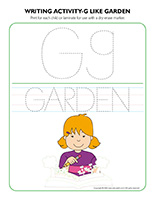
- Print an empty plate and encourage children to draw the vegetables they like most on one side and those they like least on the other side.
- Invite children to draw a recipe they would like to make.
Role play:
AT THE RESTAURANT THEMATIC BIN
- Bowls, cups, drinking glasses, plastic utensils, tablecloths, napkins, pitcher, wicker baskets, empty food packages and containers (jam, margarine, pasta, etc.), plastic food items, recipe book, restaurant menus (for delivery), cash register, notebook, crayons, play money, calculator, platters and trays, fabric flowers, candlesticks, etc.
- Set one or two tables and chairs in a corner. Display children’s artwork on the walls. Be sure to have another corner where children can prepare meals for their customers. Use this activity to show children how to set the table. (Open placemat-Set the table)
AT THE BAKERY THEMATIC BIN
- Cash register, play money, invoice booklet, crayons, measuring cups, measuring spoons, rolling pins, baking sheets, paper muffin cups, aluminum pie plates, cookie cutters, pastry bags, plastic bowls, wooden spoons, egg beater, plastic food items, clear containers with sealed lids containing flour, sugar, chocolate chips, sesame seeds, etc.), pie boxes and bread bags, beige or light brown homemade modeling dough (to make bread), an apron, a chef’s hat, oven mitts, etc.
- Set a box on its side on a table to represent an oven. Add a table that can be used to prepare recipes and set a cash register at one end.
AT THE SUPERMARKET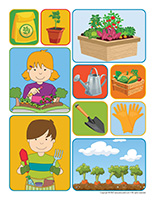
- Cash register, play money, empty food packages (cans, pasta, cereal, milk cartons, yogurt containers, etc.), baskets, reusable bags, brown paper bags, plastic fruits and vegetables, signs for identifying items and listing prices, grocery store flyers, shirts or coverups that can be used as uniforms, hair nets, utensils, plastic meats, fish, breads, etc.
- Set your cash register in one corner along with a table that will serve as a checkout counter. Set food items on shelves and encourage children to take turns pretending they are employees and customers.
Manipulation:
- Food-themed memory game using educatall.com picture games or a store-bought version.
- Puzzles related to the theme.
- Fruit scented modeling dough (bright colors) for creating fruits, vegetables, and other food items.
- Food shapes for lacing.
- Real pots and pans, kitchen utensils and instruments.
- Colorful pasta that can be threaded onto string to make bracelets and necklaces.
- Plastic vegetables that can be sorted per their size, color, etc.
- Containers filled with scents (fruits, spices, coffee, etc.).
Pre-reading:
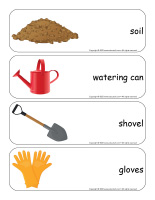
- Books about nutrition, nutrition-related professions, and food-themed picture books.
- Recipe books.
- Laminated recipe cards that children can manipulate.
- Food-themed sequential stories (such as a recipe).
Pre-writing:
- Maze activities.
- Hunt and seek activities.
- Activity sheets related to the theme.
- Games with educatall.com word flashcards.
- Tracing activities involving the names of different foods (apple, bread, pasta, etc.).
Motor skills:
- An obstacle course that children must complete with a carrot, a banana, or another food item in their hands.
- A relay race where children carry an egg (actual egg or plastic egg) in a spoon.
- Treasure hunt where children must find the ingredients for a recipe.
Sensory bins: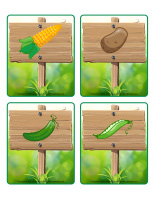
- A bin filled with dry cereal, measuring spoons, kitchen utensils, measuring cups, etc.).
- A bin filled with dry pasta or colorful rice along with kitchen utensils.
- A fin filled with water and dishwashing liquid that children can use to wash dishes.
- A bin filled with dried legumes and beans for colorful exploration.
- The possibilities are endless for this theme! Children love exploring uncommon items.
Kitchen:
- Fun recipes are perfect for this theme: cakes, cookies, fruits salad, etc. Ideally, pick recipes with several ingredients to ensure everyone has the chance to add at least one and stir.
- Taste test various items that children may be unfamiliar with.
- Explore different flavors (sweet, salty, bitter, etc.).
Science:
- Magnifying glasses and clear containers filled with various types of seeds and condiments.
- Different seeds for planting vegetables.
- A scale with different “real” food items. Children will enjoy verifying if an apple is heavier than a banana, if flour is heavier than sugar, etc.
- Explore the star and the butterfly that are hidden in an apple as well as oxidization.
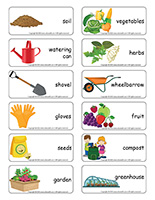
- Explore hot (oven) and cold (refrigerator).
- Set a celery stick with its leaves attached in a container filled with water and add a few drops of food coloring.
- At snack time, find unique ways to serve vegetables.
- Use food items (blueberries, beets, mustard seeds) to dye white cotton.
LANGUAGE ACTIVITIES
Stationery-Vegetables
(Open stationery-Vegetables) Print. Use the stationery to communicate with parents, in your writing corner, or to identify your thematic bins.
Word flashcards
Use the flashcards to spark a conversation with your group, in your reading and writing corner, or to identify your thematic bins. (Open word flashcards-Vegetable garden) (Open giant word flashcards-Vegetable garden) Print. soil, watering can, shovel, gloves, seeds, garden, vegetables, herbs, wheelbarrow, fruit, compost, greenhouse
Vegetables I love and dislike
(Open vegetables I love and dislike) Print, laminate, and cut out the vegetables as well as both faces. Glue each face on a paper plate and cut a slit right over each mouth. Children take turns picking a vegetable and inserting it in the slit in one of the faces, depending on whether they love or dislike it. For example, a child could insert a carrot in the smiling face and say, “I really enjoy eating carrots.” Another child could insert the broccoli in the sad face and say, “I really don’t like the taste of broccoli.”
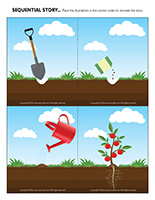
Sequential story
(Open sequential story-Vegetable garden) Print, laminate, and cut out. Have children place the illustrations in the correct order.
Vegetable garden plans
(Open game-Vegetable garden plans) Print and laminate the vegetable garden plans. For each child, print the vegetable-filled page and invite them to cut them out. For each child, you will also need 2 sheets of brown construction paper. In one sheet, cut four rows composed of 3 slits each. Help children glue only the contour of this sheet on the second sheet of brown construction paper. Have them take turns picking a vegetable garden plan. Without showing it to their peers, children name the vegetables that make up each row. For example, a child might say, “In the first row, there are radishes, lettuce in the center, and then tomatoes on the right-hand side.” The other children insert the vegetables in the slits in their garden per what they hear. Once their vegetable garden is full, they compare it with the illustrated plan used by the child who was giving instructions.
ACTIVITIES FOR BABIES
Vegetable manipulation
Set several different vegetables in a bin and let little ones manipulate them. They will have fun rolling them on the floor and transporting them everywhere.
Vegetable picture book
Collect several pictures of vegetables and use them to create a picture book that little ones can manipulate during transitions.
Vegetable path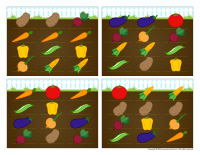
Stick several pictures of vegetables on the floor to create a path that children can crawl along. Name the vegetables as they crawl over them.
PHYSICAL ACTIVITY AND MOTOR SKILLS
Lacing-Fruits & vegetables
(Open lacing-Fruits and vegetables) Print, laminate, and punch holes around the contour of each shape. Children can use string or shoelaces to lace the shapes.
Garden game
(Open game-garden) Print six copies. Laminate and stick the illustrations on the floor so that children are able to hop from one vegetable to another identical vegetable. Name a vegetable and children must try to go from one end of the path created to the other, stepping only on this vegetable. Variation: Use one copy of each vegetable for each child in your group. For example, if there are six children in your group, print six cabbage illustrations. Play music. When the music stops, children must quickly find the vegetable you name.
In my garden
Children sit in a circle and take turns saying, “In my garden, I plant…” They name a vegetable to complete the sentence. Each child must repeat all the vegetables named by others before adding one of his own.
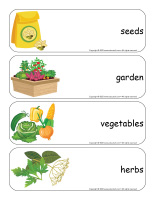
Musical vegetable
Sit in a circle with your group. To the sound of music, children pass a plastic vegetable around the circle. When the music stops, the child holding the vegetable names it and sets it on the floor in front of him. At the end of the activity, children count their vegetables to see who collected the most.
Don’t drop the potatoes
One child curls up in a ball, holding his thighs with his hands to represent a bag of potatoes. 2 or 3 of his peers pull his legs to deposit the bag of potatoes in a pre-determined area. Give each child the chance to play the role of the bag of potatoes.
OUTDOOR ACTIVITIES
Our garden
Set up a small garden in one corner of your yard and plant different types of vegetables with your group. Children will enjoy caring for their garden.
My garden obstacle course
Create an obstacle course complete with balance beams, tunnels, hula hoops, etc. Throughout the course, children collect plastic vegetables, dropping them in a basket.
ACTIVITIES INVOLVING PARENTS
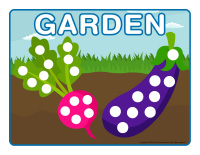
My garden
Ask parents who have a garden at home if you can visit it.
Vegetarian combo
Throughout the week, ask children to bring a vegetable of their choice that you will use to prepare a vegetarian meal. Your challenge will be to use all the vegetables provided by the children in your group. Note that if there is one vegetable that is more difficult to integrate, you can use it to decorate children’s plates. Children will love eating their unique veggie-packed combo!
COGNITIVE ACTIVITIES
Modeling dough activity placemats-Vegetable garden
(Open modeling dough activity placemats-Vegetable garden) Print and laminate. Let children pick a placemat and provide modeling dough. Encourage them to use the dough to fill or reproduce the shapes that are on their placemat.
Roll & color-Vegetable garden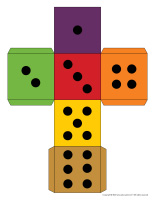
(Open roll and color-Vegetable garden) Print for each child. This game can be enjoyed individually or as a group. Children take turns rolling a die, counting the dots, and coloring the corresponding part.
Modeling dough vegetables
Give each child modeling dough. Invite them to manipulate the dough and use it to represent vegetables. Fill a large bin with dirt. Add gardening tools, plastic flowers and plants, and an empty watering can (to avoid messes). Let children plant their modeling dough vegetables in the dirt.
Counting pompoms-Vegetable garden
(Open counting pompoms-Vegetable garden) Print for each child. Children must glue the correct number of pompoms on each picture, per the number that is indicated.
Race to find vegetables
(Open playing cards-Vegetable garden) Print and laminate the playing cards and hide them throughout your daycare or yard. Divide your group into two teams. When you give the signal, children race to collect as many vegetables as possible. Set a timer.
Coloring hunt and seek-Vegetable garden
(Open coloring hunt and seek-Vegetable garden) Print and laminate. Children must find and color the items in the scene.
Game-Four vegetables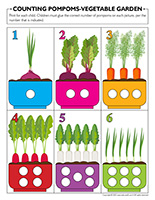
(Open game-Four vegetables) Print, glue the cards on opaque cardboard and cut them out. Arrange all the cards upside down on the floor or table (so you can’t see the illustrations). Children take turns rolling a die. Every time a child rolls a “1”, he can turn a card. If he doesn’t already have this vegetable in front of him, he keeps it and places it in front of him for everyone to see. The first child who has collected all four vegetables wins.
Magnifying glass game-Vegetables
(Open magnifying glass game-Vegetables) Print and laminate the board game and the cards. Cut the cards and store them in a box or Ziploc bag. Children take turns picking a card and searching for the illustrated item on the board game using a magnifying glass. When they find the corresponding illustration, they must deposit it in the correct square, on the board game.
Educ-assocation-Vegetables
(Open educ-association-Vegetables) Print and assemble the association game in a file folder. Children must associate the illustrations. When they find a match, they must deposit it in the corresponding square using Velcro or adhesive putty.
Educ-big and small-Vegetables
(Open educ-big and small-Vegetables) Print and laminate the game. Children must place the cards from smallest to biggest and press them in the squares using Velcro or adhesive putty).
Educ-math-Vegetables
(Open educ-math-Vegetables) Print and laminate for durable, eco-friendly use. Children must count the objects in each rectangle and circle the corresponding number.
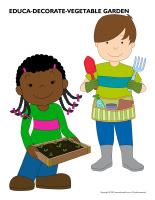
Memory game-Vegetables
(Open story and memory game-Vegetables) Print the cards twice, laminate them, and cut them out. Stick them on the lids of frozen juice cans and arrange them upside down on the floor or table. Children take turns picking two cards. If they are identical, they keep them and play again. Otherwise, their turn is over.
Association-Fruits and vegetables
(Open association-Fruits and vegetables) Print, laminate, and cut out the cards. Children must associate the fruits and vegetables to the correct poster.
MORAL AND SOCIAL ACTIVITIES
My vegetable coloring chart
(Open my vegetable coloring chart) Print for each child. Invite children to complete the chart throughout the theme. At the end of the week, count how many vegetables children ate. Encourage them to name the vegetables they enjoyed eating the most and which ones they weren’t too fond of.
(Open game-In my pot) Children cut food items out of grocery store flyers and glue them inside their pot to create a recipe.
Mr. Potato
Give each child a potato and colorful toothpicks. Prepare a platter filled with various food items such as marshmallows, sliced bananas, raisins, sliced apples, strawberries, etc. Children use the toothpicks to prick food items in their potato and create a silly face.
Gardening area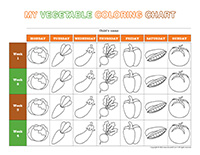
Organize a special gardening area within your daycare. Fill a bin with soil and add gardening tools, plastic vegetables, and an empty watering can (to avoid spills). Children will have fun pretending they are gardeners.
Variation: Add a container filled with water that children can use to wash the vegetables.
Group plantation
Display a banner on a wall (or fence). At the bottom of the banner, glue seeds and ask children to draw what they think will grow.
EARLY SCIENCE
Garden manipulation bin
Fill a bin with soil and add a few vegetables with leaves attached to represent a garden. Provide gardening tools.
My vegetable garden
Each child plants seeds in one section of a vegetable garden (a shallow wooden crate or plastic bin divided into sections). Encourage them to care for their garden until they can harvest the vegetables they planted.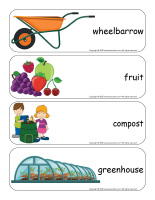
The cut potato
Cut a potato in half. Leave one half on a plate where children can observe it. Set the other half in a container filled with water. Observe both potatoes often throughout the day and week and compare them.
Colorful celery
Set a celery stalk with its leaves attached in a container filled with water and add a few drops of food coloring. The leaves will change color. If you wish, give each child his own celery stalk and let them add a few drops of food coloring, letting them pick the color they prefer. Write each child’s name on his container.
Corn roast
In your yard, husk corn with your group and cook it for lunch. If you wish, invite parents to join you!
Mashing potatoes
Cook potatoes and let children mash them in their plate.
Red potatoes, white potatoes, yellow potatoes, bleu potatoes
Observe, manipulate, and taste different types of potatoes with your group.
CULINARY ACTIVITIES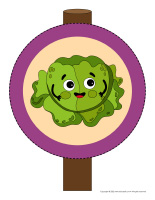
Tasting local products
Present a wide variety of locally grown vegetables. Choose vegetables that children are familiar with and others that are more exotic. Offer vegetables that can be eaten raw and cooked.
Vegetable characters
Let children use their imagination to create characters in their plate. Provide cut carrots, celery sticks with leaves attached, peas, salad, green peppers, parsley, cucumber slices, etc.
ARTS & CRAFTS
My hat-Vegetables
(Open educa-decorate-Vegetable garden) Print and cut out the items. Glue them on a paper headband.
Models-Vegetable garden
(Open models-Vegetable garden) Print the various models and use them for different activities and projects throughout the theme.
Healthy puppets
(Open models-vegetables) Print for each child. Have children color the vegetables, cut them out (depending on their age) and glue faces on them. When they are done, they can glue Popsicle sticks behind each one to complete their puppets.
Vegetable mobile
(Open mobile-Vegetables) Print for each child. Have children color the various parts and assemble them to create a mobile. You can use a clothes hanger, a plastic bowl with holes in it, or a paper bowl as a support for your mobile.
Crumpled vegetables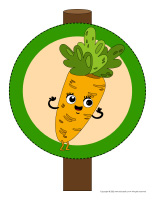
Trace or print a vegetable shape on heavy paper and have children fill the outline with crumpled tissue paper.
Three-dimensional vegetables
Provide modeling dough or salt dough that children can use to represent colorful vegetables. Set their creations out to dry.
Veggie painting
Use vegetables (celery, carrots, potatoes, etc.) to paint on a paper tablecloth. The celery heart, when cut at the base, looks like a rose, an apple’s core can be used to stamp a star shape, etc.
Giant vegetables
Trace vegetable outlines on 2 large pieces of cardboard (2 of each). Cut them out and staple the contour, leaving a small opening. Stuff the shapes with newspaper and staple them shut. Invite children to paint their giant vegetables.
Corn painting
Set a large white paper banner on a table. Provide corn husks and let children roll them in paint and then on the paper.
Vegetable art
Visit your local supermarket and ask them for vegetables that are past their prime. Use them for a painting activity. An asparagus spear makes a great paintbrush, the tip of a carrot makes a great pen, etc.
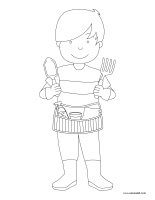
CREATIVE COLORING
(Open creative coloring-Vegetables) Print for each child. Ask children to draw the vegetables they would add to their soup.
COLORING PAGES
(Open coloring pages theme-Vegetable garden) Print for each child.
(Open coloring pages theme-Vegetables) Print for each child.
Have fun!
The educatall team
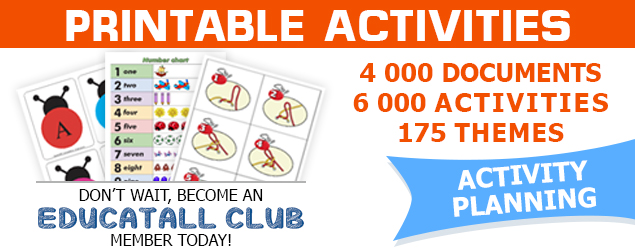
 Home
Home Theme activities
Theme activities
 Babies and toddlers
Babies and toddlers
 Arts and crafts
Arts and crafts
 Science
Science
 Creative recipes
Creative recipes
 Tips and tricks
Tips and tricks
 Special needs
Special needs
 Extra activities
Extra activities
 Educ-TV
Educ-TV
 Newsletter
Newsletter  Online store
Online store Educatall club
Educatall club

